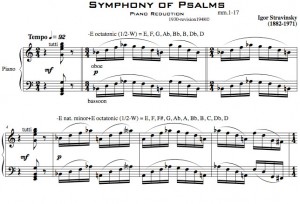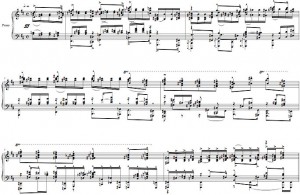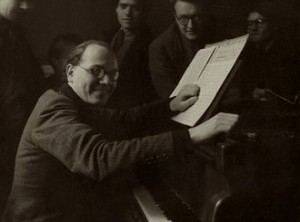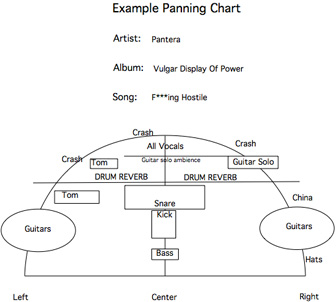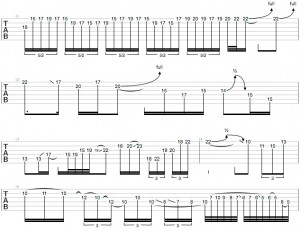In the last column, we talked about harmonizing the Major Scale in 3rds so that we could find all diatonic chords for that scale from each of its degrees. In doing so we ended up harmonizing every degree of that scale until we had every possible diatonic tension stacked on all of the seven degrees of said scale.
For this column, the goal will be much the same. We will continue with the tertian harmonization and apply it to natural minor, melodic minor, and finally harmonic minor scales. What will happen is that we will then have seven different chord types for each scale; and all possible tensions that could theoretically be available over each degree of each scale.
Once again, I will use the note C as tonic for our scales. Every scale can be transposed to any other key.
C Natural Minor
[C D Eb F G Ab Bb C] = [W, ½, W, W, ½, W, W]
1
![]()
Looking carefully at this scale, you will notice it is actually an inversion of an Eb major scale (meaning all chords/tensions that are found in this scale are also found in Eb major). Not surprisingly, you will find that C natural minor is a MODE of Eb major. The next page lists all possible chords/tensions for this scale.
C Natural Minor with each scale degree harmonized to include every possible tension on each given degree:
2

Here is what you get:

Our next minor scale does not share the same intervallic ratio as either the Major Scale or any of its modes.
C Melodic Minor
[C D Eb F G A B C] = [W, ½, W, W, W, W, ½]
3

Once again we have the harmonization of each degree so that we can see all possible tensions and chord tones on any given chord.

There are two possible names for the VII chord of the melodic minor scale: B7 b9 #9 b5 #5 (known as B7alt) or Bm7b5 b9 (b4) b13
The reason you can get two chords here is actually a bit tricky. Look at the b4 you find in this last inversion of the scale – it is better heard as a major 3rd of a dominant chord as opposed to a b4 against a diminished triad. Because of this, the 4th degree of this 7th mode of melodic minor (whose formula is 1 b2 b3 b4 b5 b6 b7) will usually be organized so that the b4 is harmonically taken as a major 3rd and the b3 as a #9. In the end you get a chord that is as the formula implies: B7b5 (B D# F A) with tensions b9 (C), #9 (D), and #5 (F##/G).
The last scale we will be looking at in this lesson is the Harmonic Minor Scale. Once again it does not share the same intervallic ratio to either the melodic minor scale or the natural minor scale (or any of their Modes).
C Harmonic Minor
[C D Eb F G Ab B C] = [W, ½, W, W, ½, 1½, ½]
Harmonic Minor is an interesting scale; as opposed to both natural minor and melodic minor whose intervals are always either a whole step or a ½ step in distance, the harmonic minor scale gaps an augmented 2nd between its 6th and 7th degrees. This melodic jump is much more common in eastern cultures (the music of India, Arabia, etc.) than in Western music. That is not to imply that this augmented 2nd never gets used in western music. You can find examples of it in various works.
Take for instance the 20th fugue in A minor from the 1st book of the Well-Tempered Clavier by J.S Bach. Bach plays with this idea of the augmented 2nd, but instead of simply ascending the harmonic minor scale to include the augmented 2nd interval, he takes a drastic leap down a diminished 7th in the fugue’s subject. (F natural to G# or le down to ti) Bach will later develop this subject against itself in canon at various interval levels (canon at the octave, canon at the 5th, etc). Hear and study the XXth fugue in its entirety HERE.
4

The augmented 2nd used to be treated with care when used melodically, but this interval can now be found in various works, by various different artists, in a horde of different musical styles. The augmented 2nd has become very popular in rock/metal, as well as in flamenco and other musical styles. Now back to harmonizing!
C Harmonic Minor scale harmonized with all its possible tensions:
5

Remember that the point of these examples is not that you play these seven note chords, but that you search for tensions that you want to incorporate into your triads and 7ths chords. That is not to say that you cannot use your imagination and actually find a use for all seven tones being played as a diatonic cluster – it has been done by various composers, though, such clusters are usually not tertian in nature and would also not be very easily playable on guitar! (In a future column we will touch upon other harmonizations and commonly used clusters by various composers of the XXth century.) Here is the harmonization of harmonic minor:

Now that you have all the possible tensions for every single degree of all 3 minor scales we covered here try to come up with as many voicings that you can for each chord on your instrument. Try to build your voicings around the triads and 7th chords and see which tensions you like the most over each chord, build a vocabulary for yourself that incorporates all these different voicings and make sure you try these examples in other keys as well. After that, attempt to put together chord progressions with chords from each scale and eventually try to string together a progression that incorporates chords from all 3 minor scales together. Once again, the limitation is only the imagination; there are hundreds of possible voicings for each chord!
Roberto’s currently listening to: Franz Liszt – B Minor Sonata



